| Talos was a human-like giant made of copper -
probably invented by Daidalos, and equipped with a single vein from head
to heel, which was closed by a nail in its ankle.
|
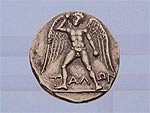
|
| The Cretan word 'talos' corresponds to the Greek 'helios',
which means 'sun' |
|
|
|
|
|
There
are several variants of its creation. Apollodoros (5th cent. BC) believes
that it was created by the god Hefaistos, who gave it to Minos. Platon
considers it to be a real person and Radamanthys' brother. Apollonios (3rd
cent. BC) from Rhodes mentions that it was a gift from Zeus to Europa, who later passed it on to their son Minos. |
|
|
|
|
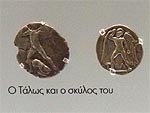
|
Talos was extremely fast with his winged shoulders,
so his task was to guard Crete against pirates and other enemies as well
as to ensure that the laws were observed in all the cities.
|
| Three times a day, the gigant ran around Crete and
scouted for assaulting enemies, whom it chased away by throwing huge
cliffs after them. If, nevertheless, an enemy managed to penetrate into
the island, Talos caught him and hugged him into its fist and tored into a
bonfire, until its body became red hot. The fire did not hurt the giant, but the situation
was indeed worse for the enemy. |
|
|
|
|
| Talos did also have the task to ensure that the laws,
which Minos received by his father Zeus during his frequent visits to the
Psiloritis cave, were kept. It therefore traveled three times a year to
all the cities of Crete with the bronze plates, in which the laws were
engraved. |
|
|
|
|
| Since Talos was not human, it was, in principle,
immortal, but when Jason and the Argonauts returned from Colchis after
having retrieved the golden fleece, they also came to Crete. Here the
witch Medea enchanted the giant into a passive and willless creature. When it
was passivated, she pulled the nail out of its ankle, so it blew and
eventually died.
|
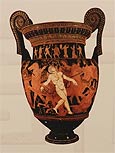
|
|
This strange creature, which has some resemblance to
a robot, has given rise to discussions about developed technology in
ancient Crete. |
|
|
|
|
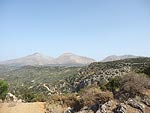 |
When Talos was not on the move, it lived on the
summit (1076 m) of Talaia Ori, also known as Kouloukonas, which are
situated on the northern coast between Rethymno and Iraklion. The
mountains consist of plattenkalk (limestone) and are 250 million. years
old, formed under the sea. They consist of three separate summits and a
few smaller, separated from Psiloritis by the fertile Mylopotamos valley. On the western summit there
is a church of Timios Stavros. |
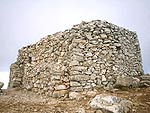
|
|
|
|
|
|
|
|
|
|
|
|
|
|
|
|
|
|
|
|
|
|
|
|
|
|
|
|
|
|
|
|
|
|
|
|
|
|
|
|
|
|
|
|
|
|
|
|




